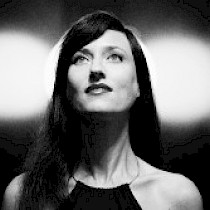Prof. Vesna Petresin

Vesna Petresin (born in Ljubljana, works and lives in Berlin and London) is a transdisciplinary artist and thinker. She has a practice as a time-architect, composing and performing with sound, light, rhythm, space, movement, text and code.
Currently a Visiting Fellow with Goldsmiths College, University of London, and an Artist-in-Residence with ZKM Center for Art and Media, Vesna earned her PhD for research on temporal composition in architecture, art and music. In 2004 she co-founded the London-based art collective and think-tank Rubedo, investigating themes and techniques in aesthetics, complex geometry, optics and acoustics, through performance, installation and artefact.
Vesna’s practice explores embodiment, transformation, manipulation of time and movement, synaesthesia in syncretic art, alongside the barriers between the intimate and the public sphere. She aims at taking art out of the ‘white cube’ to an immersive experience and to explore sound in relation to space, time and user interaction. Using her voice and movement meditation, she constructs a trichotomy of structures: sound, image and light, exploring the concept of time in relation to body, movement, space and emotions.
She has exhibited and delivered performances, immersive experiences, multimedia installations and artefacts to international festivals and venues at Tate Modern, ArtBasel Miami, Royal Festival Hall, Royal Academy of Arts, Venice Biennale, Cannes International Film Festival, Institute of Contemporary Arts London, CERN, Sydney Opera House, Vienna Secession, World Architecture Festival and Beijing Architecture Biennale.
Vesna also acted as Industry Advisor to Goldsmiths College [Topology Research Unit], Bath University, and received industry and arts grants (British Council, UK Govt. Department of Innovation, Business and Skills, Arts Council, Crafts Council), as well as patents in engineering. She has been a lecturer and public speaker (UCL, Goldsmiths, Central Saint Martins, Architectural Association, ZKM among others), published internationally (Thames & Hudson, Springer, John Wiley & Academy) and has been a Fellow of the Royal Society of Arts.
Synopsis
Present continuous
Matter is information.
As the world of technology focuses on the the process from bits to particles and from particles back to bits, the impact of social change through technology gives rise to a digital world order. Here, our value is defined by what we contribute to data processing.
The culture of flow, Interaction, sharing, tracking, prosuming, redefines ways in which we learn, work, trade, communicate and relax.
In the world when the ancient myths are fused with emergent godlike technologies such as artificial intelligence and genetic engineering, how will we define what it means to be human?
Instant manifestation is the new holy grail, as desire rapidly becomes experience.
To escape the threat of the Real, we created a virtual utopia - a traumatic scene that never really took place. It is a false liberation from the constraints of the social space in which our existence is caught.
In this avalanche of growth and abundance, the gap with the world of poverty and abuse of human rights is increasing. It may be timely to pause and question, to reconsider the art of consciousness, to reflect and act in the present to shape a future through values of humanism, including personal freedom of expression, sexual emancipation, and environmental responsibility.
People are driven by stories as much as by physical existence. Thinking through making art may show alternative to creating narratives, creating desirable improbabilities for our future, and bringing nature and technology together in exciting and meaningful new ways.
All Speakers
- Yasser Almaamoun
- Thorsten Bauer
- Sergey Biniaminov
- Christopher Coenen
- Prof. Ina Conradi
- Prof. Dr.-Ing. Barbara Deml
- Hon. Prof. Joséphine Derobe
- Florian Dohmann
- Felix Gaedtke
- Diego González-Zúñiga
- Prof. Lisa Gotto
- Dr. Lily Hibberd
- Prof. Johan Frederik Hartle
- Dr. Rocio von Jungenfeld
- Sönke Kirchhof
- Mario Klingemann
- Dr. Elias Knubben
- Dr. Sebastian Knorr
- Prof. Verena Kraemer
- Prof. Susanne Kriemann
- Dr. Barbara Kuon
- Prof. Frederic Fol Leymarie
- Roman Lipski
- Anja-Maria Meister
- Prof. Galina Mihaleva
- Prof. Dr. Eduardo R. Miranda
- Lauren Moffatt
- Prof. Julian Oliver
- Prof. Dr. Dr.-Ing. Jivka Ovtcharova
- Gülsel Özkan
- Prof. Matteo Pasquinelli
- Prof. Vesna Petresin
- Prof. Dr. Mark Post
- Oliver Rack
- Prof. Elke Reinhuber
- Prof. Christiane Riedel
- Dr. Ralf Schäfer
- Prof. Benjamin Seide
- Dr. Markus Schmidt
- Kathleen Schröter
- Prof. Aljoscha Smolic
- Prof. Vibeke Sorensen
- Prof. João Tabarra
- Cyril Tuschi
- Holger Volland
- Dr. Lioudmila Voropai
- Yulu Wang
Contact
Interesse? Fragen?
Rufen Sie uns an:
+49 (0)721 / 8100 6001
oder schreiben Sie uns:
info@beyondfestival.com




